impact on the country's development Assignment PDF
VerifiedAdded on 2021/08/03
|15
|3780
|66
AI Summary
Contribute Materials
Your contribution can guide someone’s learning journey. Share your
documents today.

Secure Best Marks with AI Grader
Need help grading? Try our AI Grader for instant feedback on your assignments.
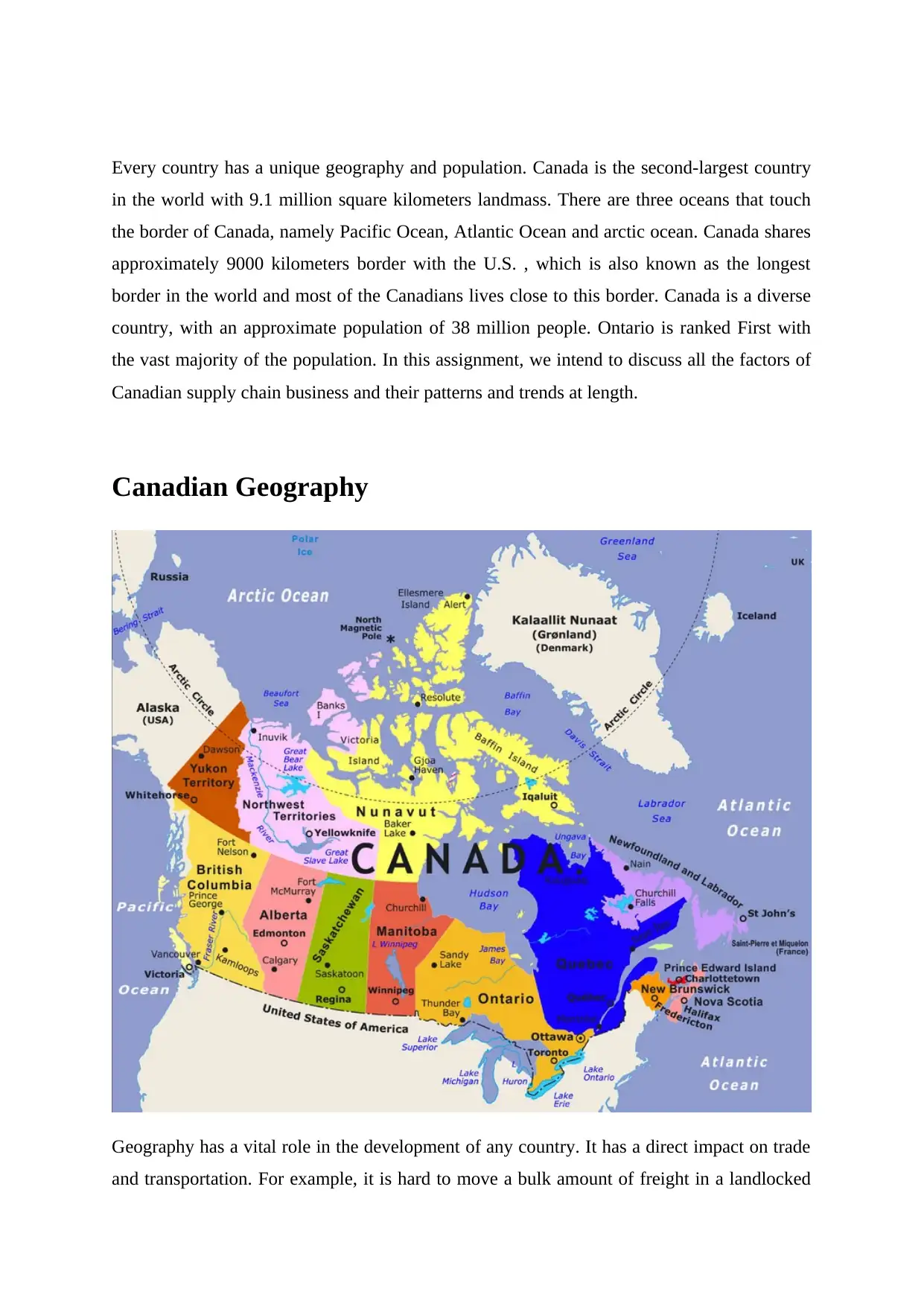
Every country has a unique geography and population. Canada is the second-largest country
in the world with 9.1 million square kilometers landmass. There are three oceans that touch
the border of Canada, namely Pacific Ocean, Atlantic Ocean and arctic ocean. Canada shares
approximately 9000 kilometers border with the U.S. , which is also known as the longest
border in the world and most of the Canadians lives close to this border. Canada is a diverse
country, with an approximate population of 38 million people. Ontario is ranked First with
the vast majority of the population. In this assignment, we intend to discuss all the factors of
Canadian supply chain business and their patterns and trends at length.
Canadian Geography
Geography has a vital role in the development of any country. It has a direct impact on trade
and transportation. For example, it is hard to move a bulk amount of freight in a landlocked
in the world with 9.1 million square kilometers landmass. There are three oceans that touch
the border of Canada, namely Pacific Ocean, Atlantic Ocean and arctic ocean. Canada shares
approximately 9000 kilometers border with the U.S. , which is also known as the longest
border in the world and most of the Canadians lives close to this border. Canada is a diverse
country, with an approximate population of 38 million people. Ontario is ranked First with
the vast majority of the population. In this assignment, we intend to discuss all the factors of
Canadian supply chain business and their patterns and trends at length.
Canadian Geography
Geography has a vital role in the development of any country. It has a direct impact on trade
and transportation. For example, it is hard to move a bulk amount of freight in a landlocked
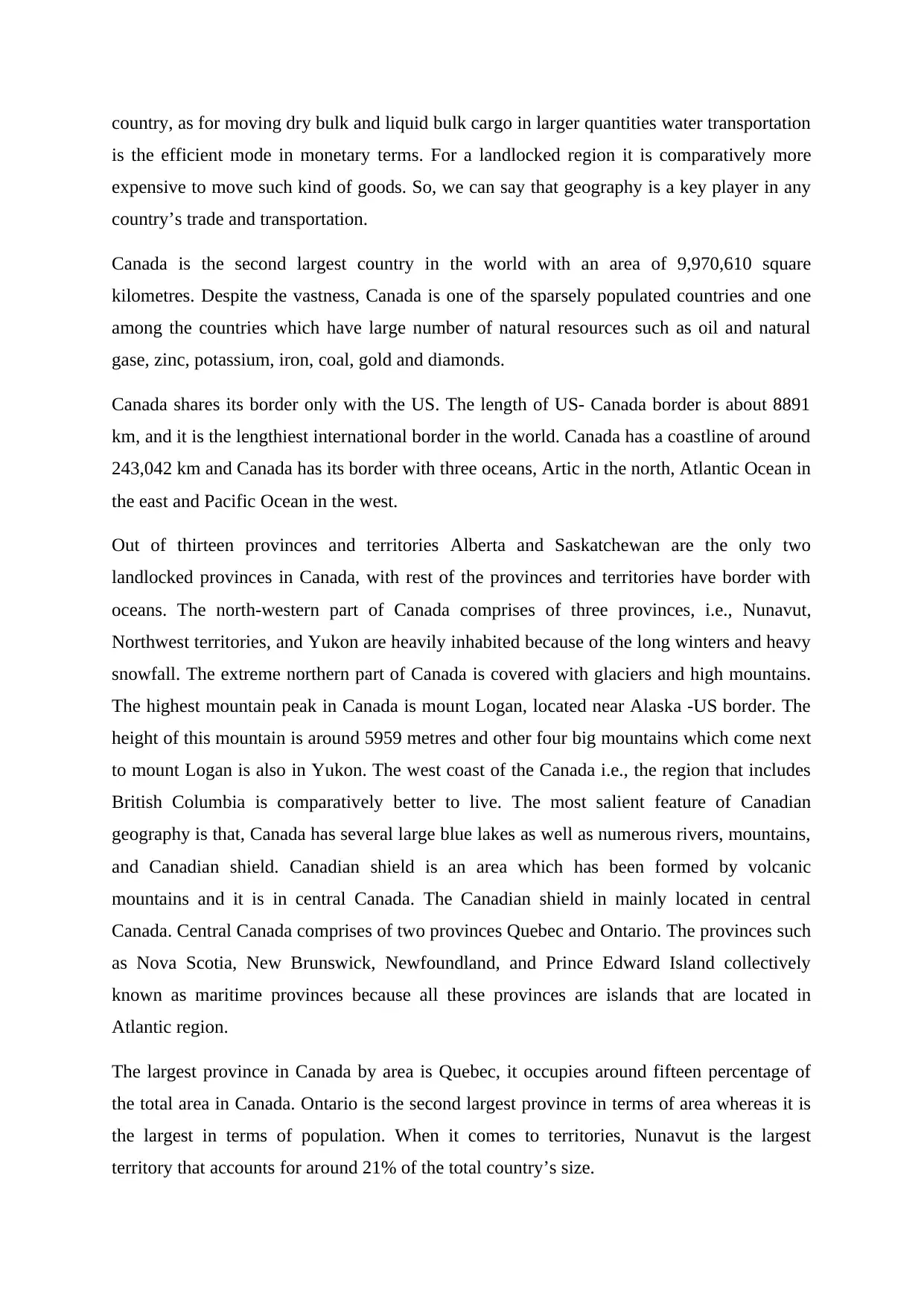
country, as for moving dry bulk and liquid bulk cargo in larger quantities water transportation
is the efficient mode in monetary terms. For a landlocked region it is comparatively more
expensive to move such kind of goods. So, we can say that geography is a key player in any
country’s trade and transportation.
Canada is the second largest country in the world with an area of 9,970,610 square
kilometres. Despite the vastness, Canada is one of the sparsely populated countries and one
among the countries which have large number of natural resources such as oil and natural
gase, zinc, potassium, iron, coal, gold and diamonds.
Canada shares its border only with the US. The length of US- Canada border is about 8891
km, and it is the lengthiest international border in the world. Canada has a coastline of around
243,042 km and Canada has its border with three oceans, Artic in the north, Atlantic Ocean in
the east and Pacific Ocean in the west.
Out of thirteen provinces and territories Alberta and Saskatchewan are the only two
landlocked provinces in Canada, with rest of the provinces and territories have border with
oceans. The north-western part of Canada comprises of three provinces, i.e., Nunavut,
Northwest territories, and Yukon are heavily inhabited because of the long winters and heavy
snowfall. The extreme northern part of Canada is covered with glaciers and high mountains.
The highest mountain peak in Canada is mount Logan, located near Alaska -US border. The
height of this mountain is around 5959 metres and other four big mountains which come next
to mount Logan is also in Yukon. The west coast of the Canada i.e., the region that includes
British Columbia is comparatively better to live. The most salient feature of Canadian
geography is that, Canada has several large blue lakes as well as numerous rivers, mountains,
and Canadian shield. Canadian shield is an area which has been formed by volcanic
mountains and it is in central Canada. The Canadian shield in mainly located in central
Canada. Central Canada comprises of two provinces Quebec and Ontario. The provinces such
as Nova Scotia, New Brunswick, Newfoundland, and Prince Edward Island collectively
known as maritime provinces because all these provinces are islands that are located in
Atlantic region.
The largest province in Canada by area is Quebec, it occupies around fifteen percentage of
the total area in Canada. Ontario is the second largest province in terms of area whereas it is
the largest in terms of population. When it comes to territories, Nunavut is the largest
territory that accounts for around 21% of the total country’s size.
is the efficient mode in monetary terms. For a landlocked region it is comparatively more
expensive to move such kind of goods. So, we can say that geography is a key player in any
country’s trade and transportation.
Canada is the second largest country in the world with an area of 9,970,610 square
kilometres. Despite the vastness, Canada is one of the sparsely populated countries and one
among the countries which have large number of natural resources such as oil and natural
gase, zinc, potassium, iron, coal, gold and diamonds.
Canada shares its border only with the US. The length of US- Canada border is about 8891
km, and it is the lengthiest international border in the world. Canada has a coastline of around
243,042 km and Canada has its border with three oceans, Artic in the north, Atlantic Ocean in
the east and Pacific Ocean in the west.
Out of thirteen provinces and territories Alberta and Saskatchewan are the only two
landlocked provinces in Canada, with rest of the provinces and territories have border with
oceans. The north-western part of Canada comprises of three provinces, i.e., Nunavut,
Northwest territories, and Yukon are heavily inhabited because of the long winters and heavy
snowfall. The extreme northern part of Canada is covered with glaciers and high mountains.
The highest mountain peak in Canada is mount Logan, located near Alaska -US border. The
height of this mountain is around 5959 metres and other four big mountains which come next
to mount Logan is also in Yukon. The west coast of the Canada i.e., the region that includes
British Columbia is comparatively better to live. The most salient feature of Canadian
geography is that, Canada has several large blue lakes as well as numerous rivers, mountains,
and Canadian shield. Canadian shield is an area which has been formed by volcanic
mountains and it is in central Canada. The Canadian shield in mainly located in central
Canada. Central Canada comprises of two provinces Quebec and Ontario. The provinces such
as Nova Scotia, New Brunswick, Newfoundland, and Prince Edward Island collectively
known as maritime provinces because all these provinces are islands that are located in
Atlantic region.
The largest province in Canada by area is Quebec, it occupies around fifteen percentage of
the total area in Canada. Ontario is the second largest province in terms of area whereas it is
the largest in terms of population. When it comes to territories, Nunavut is the largest
territory that accounts for around 21% of the total country’s size.
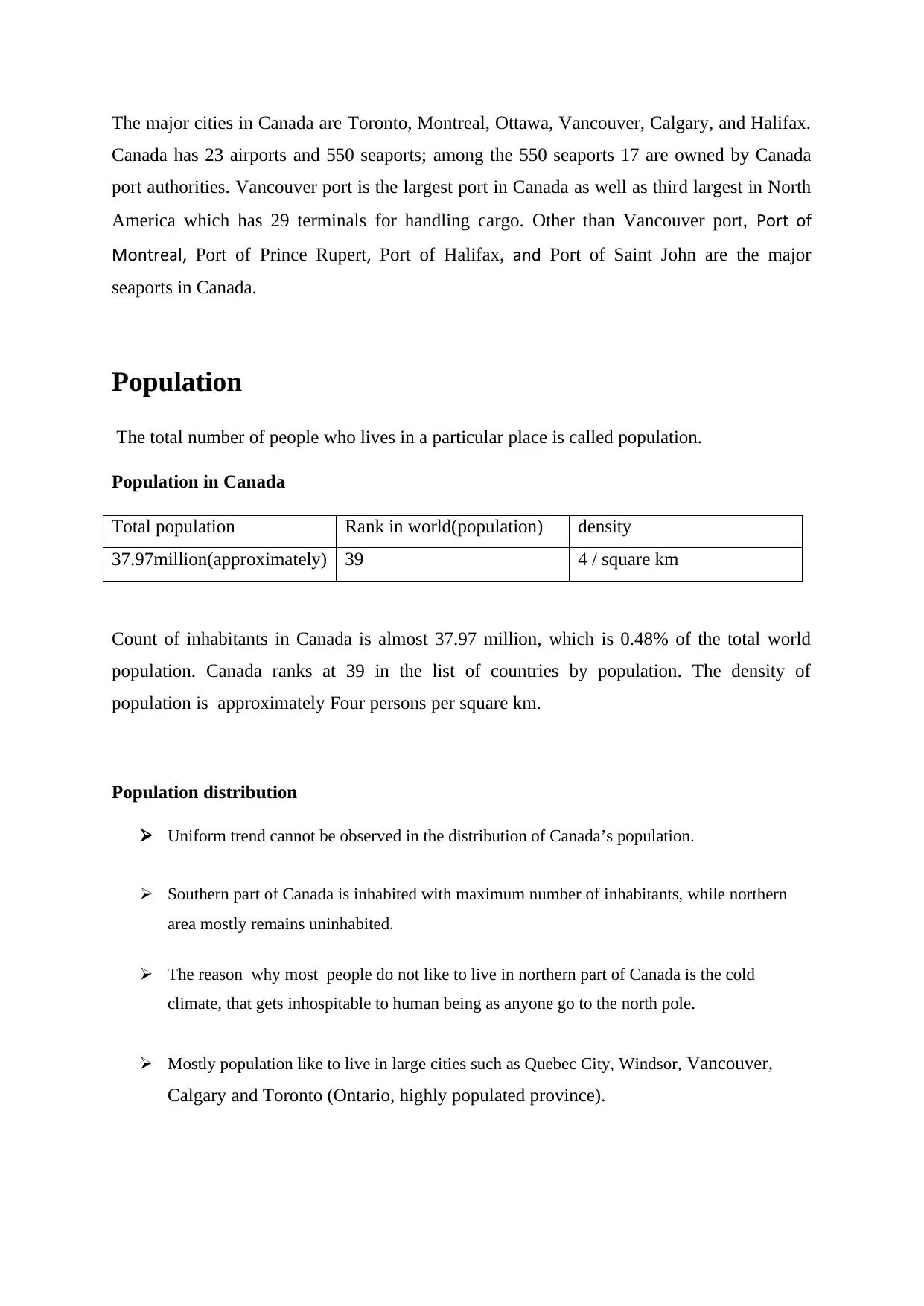
The major cities in Canada are Toronto, Montreal, Ottawa, Vancouver, Calgary, and Halifax.
Canada has 23 airports and 550 seaports; among the 550 seaports 17 are owned by Canada
port authorities. Vancouver port is the largest port in Canada as well as third largest in North
America which has 29 terminals for handling cargo. Other than Vancouver port, Port of
Montreal, Port of Prince Rupert, Port of Halifax, and Port of Saint John are the major
seaports in Canada.
Population
The total number of people who lives in a particular place is called population.
Population in Canada
Total population Rank in world(population) density
37.97million(approximately) 39 4 / square km
Count of inhabitants in Canada is almost 37.97 million, which is 0.48% of the total world
population. Canada ranks at 39 in the list of countries by population. The density of
population is approximately Four persons per square km.
Population distribution
Uniform trend cannot be observed in the distribution of Canada’s population.
Southern part of Canada is inhabited with maximum number of inhabitants, while northern
area mostly remains uninhabited.
The reason why most people do not like to live in northern part of Canada is the cold
climate, that gets inhospitable to human being as anyone go to the north pole.
Mostly population like to live in large cities such as Quebec City, Windsor, Vancouver,
Calgary and Toronto (Ontario, highly populated province).
Canada has 23 airports and 550 seaports; among the 550 seaports 17 are owned by Canada
port authorities. Vancouver port is the largest port in Canada as well as third largest in North
America which has 29 terminals for handling cargo. Other than Vancouver port, Port of
Montreal, Port of Prince Rupert, Port of Halifax, and Port of Saint John are the major
seaports in Canada.
Population
The total number of people who lives in a particular place is called population.
Population in Canada
Total population Rank in world(population) density
37.97million(approximately) 39 4 / square km
Count of inhabitants in Canada is almost 37.97 million, which is 0.48% of the total world
population. Canada ranks at 39 in the list of countries by population. The density of
population is approximately Four persons per square km.
Population distribution
Uniform trend cannot be observed in the distribution of Canada’s population.
Southern part of Canada is inhabited with maximum number of inhabitants, while northern
area mostly remains uninhabited.
The reason why most people do not like to live in northern part of Canada is the cold
climate, that gets inhospitable to human being as anyone go to the north pole.
Mostly population like to live in large cities such as Quebec City, Windsor, Vancouver,
Calgary and Toronto (Ontario, highly populated province).
Secure Best Marks with AI Grader
Need help grading? Try our AI Grader for instant feedback on your assignments.

The main reason why these all cities are mostly populated is because they are near to the US
border which is Canada’s only neighbouring nation and also climate at this particular places
is not extreme unlike many other cold provinces.
Province/city Number of residents in thousands
Toronto / Ontario 6,555.2
Montreal, Quebec 4,364.19
Vancouver, British Columbia 2,737.7
Calgary, Alberta 1,543.28
Edmonton, Alberta 1,468.93
Winnipeg, Manitoba 850.06
Quebec, Quebec 832.33
According to this data highest number of population can be seen in Toronto, while in Quebec
the number of residents is lowest than other all provinces. (satista.com)
Geographical Distribution Of Canada
Canada is the second largest country of the world with an area of 9.98 million square
kilometres (approx.). It has three territories and ten provinces. It touches the great Pacific
Ocean from its left side and to the Atlantic Ocean from its right side. Every Province of
Canada has their different weather and geographical conditions. The name of provinces in
Canada are: -
border which is Canada’s only neighbouring nation and also climate at this particular places
is not extreme unlike many other cold provinces.
Province/city Number of residents in thousands
Toronto / Ontario 6,555.2
Montreal, Quebec 4,364.19
Vancouver, British Columbia 2,737.7
Calgary, Alberta 1,543.28
Edmonton, Alberta 1,468.93
Winnipeg, Manitoba 850.06
Quebec, Quebec 832.33
According to this data highest number of population can be seen in Toronto, while in Quebec
the number of residents is lowest than other all provinces. (satista.com)
Geographical Distribution Of Canada
Canada is the second largest country of the world with an area of 9.98 million square
kilometres (approx.). It has three territories and ten provinces. It touches the great Pacific
Ocean from its left side and to the Atlantic Ocean from its right side. Every Province of
Canada has their different weather and geographical conditions. The name of provinces in
Canada are: -
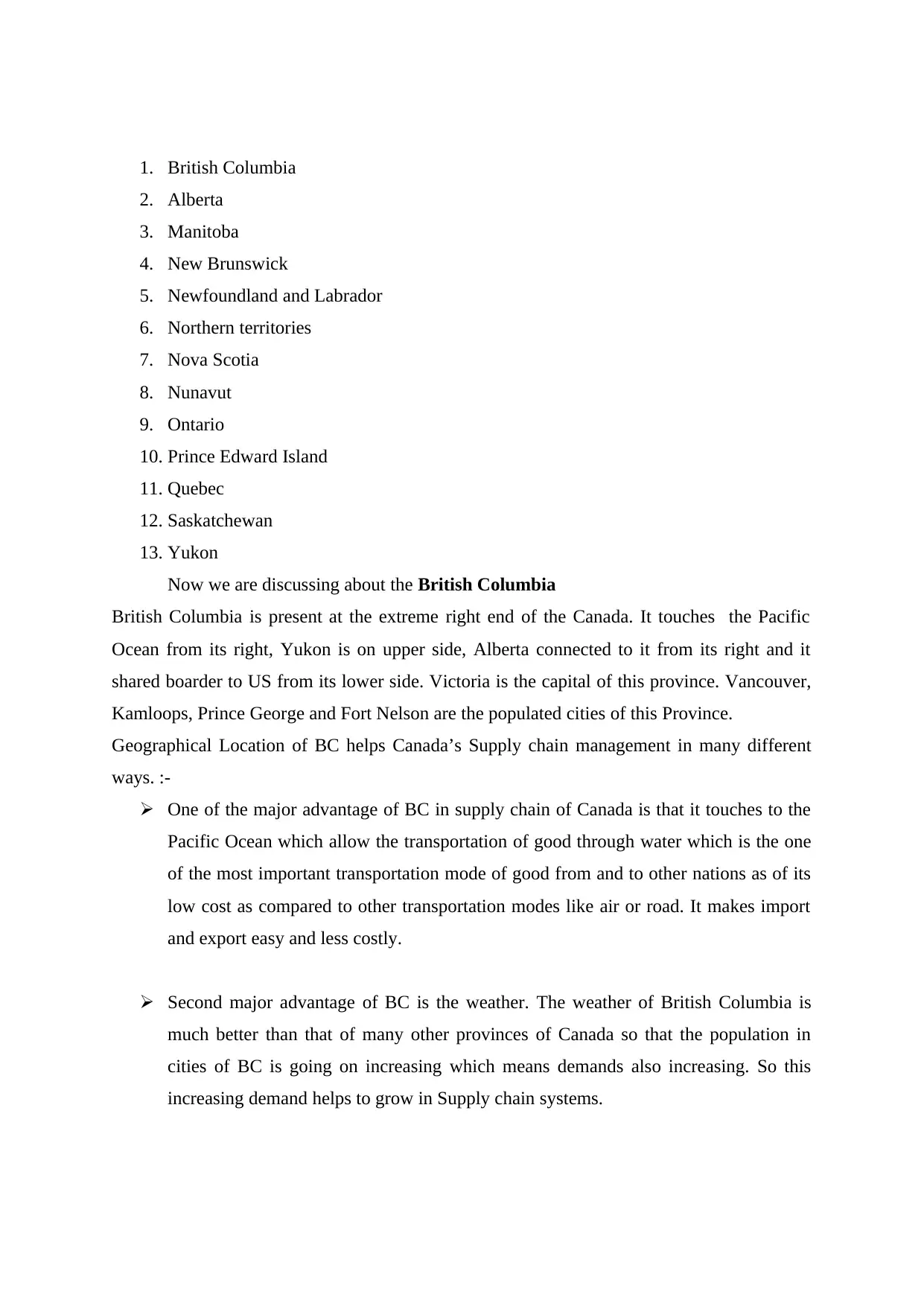
1. British Columbia
2. Alberta
3. Manitoba
4. New Brunswick
5. Newfoundland and Labrador
6. Northern territories
7. Nova Scotia
8. Nunavut
9. Ontario
10. Prince Edward Island
11. Quebec
12. Saskatchewan
13. Yukon
Now we are discussing about the British Columbia
British Columbia is present at the extreme right end of the Canada. It touches the Pacific
Ocean from its right, Yukon is on upper side, Alberta connected to it from its right and it
shared boarder to US from its lower side. Victoria is the capital of this province. Vancouver,
Kamloops, Prince George and Fort Nelson are the populated cities of this Province.
Geographical Location of BC helps Canada’s Supply chain management in many different
ways. :-
One of the major advantage of BC in supply chain of Canada is that it touches to the
Pacific Ocean which allow the transportation of good through water which is the one
of the most important transportation mode of good from and to other nations as of its
low cost as compared to other transportation modes like air or road. It makes import
and export easy and less costly.
Second major advantage of BC is the weather. The weather of British Columbia is
much better than that of many other provinces of Canada so that the population in
cities of BC is going on increasing which means demands also increasing. So this
increasing demand helps to grow in Supply chain systems.
2. Alberta
3. Manitoba
4. New Brunswick
5. Newfoundland and Labrador
6. Northern territories
7. Nova Scotia
8. Nunavut
9. Ontario
10. Prince Edward Island
11. Quebec
12. Saskatchewan
13. Yukon
Now we are discussing about the British Columbia
British Columbia is present at the extreme right end of the Canada. It touches the Pacific
Ocean from its right, Yukon is on upper side, Alberta connected to it from its right and it
shared boarder to US from its lower side. Victoria is the capital of this province. Vancouver,
Kamloops, Prince George and Fort Nelson are the populated cities of this Province.
Geographical Location of BC helps Canada’s Supply chain management in many different
ways. :-
One of the major advantage of BC in supply chain of Canada is that it touches to the
Pacific Ocean which allow the transportation of good through water which is the one
of the most important transportation mode of good from and to other nations as of its
low cost as compared to other transportation modes like air or road. It makes import
and export easy and less costly.
Second major advantage of BC is the weather. The weather of British Columbia is
much better than that of many other provinces of Canada so that the population in
cities of BC is going on increasing which means demands also increasing. So this
increasing demand helps to grow in Supply chain systems.
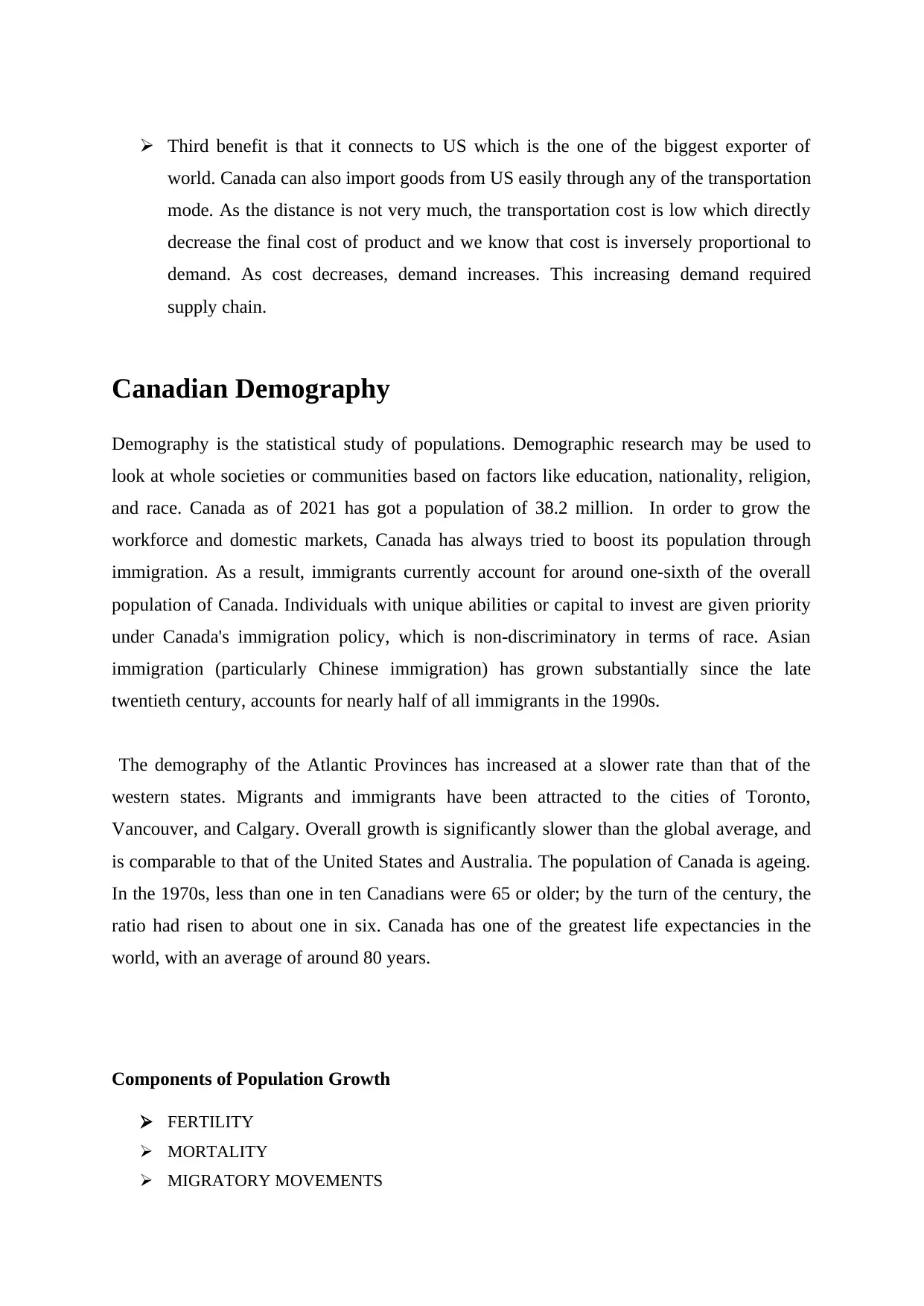
Third benefit is that it connects to US which is the one of the biggest exporter of
world. Canada can also import goods from US easily through any of the transportation
mode. As the distance is not very much, the transportation cost is low which directly
decrease the final cost of product and we know that cost is inversely proportional to
demand. As cost decreases, demand increases. This increasing demand required
supply chain.
Canadian Demography
Demography is the statistical study of populations. Demographic research may be used to
look at whole societies or communities based on factors like education, nationality, religion,
and race. Canada as of 2021 has got a population of 38.2 million. In order to grow the
workforce and domestic markets, Canada has always tried to boost its population through
immigration. As a result, immigrants currently account for around one-sixth of the overall
population of Canada. Individuals with unique abilities or capital to invest are given priority
under Canada's immigration policy, which is non-discriminatory in terms of race. Asian
immigration (particularly Chinese immigration) has grown substantially since the late
twentieth century, accounts for nearly half of all immigrants in the 1990s.
The demography of the Atlantic Provinces has increased at a slower rate than that of the
western states. Migrants and immigrants have been attracted to the cities of Toronto,
Vancouver, and Calgary. Overall growth is significantly slower than the global average, and
is comparable to that of the United States and Australia. The population of Canada is ageing.
In the 1970s, less than one in ten Canadians were 65 or older; by the turn of the century, the
ratio had risen to about one in six. Canada has one of the greatest life expectancies in the
world, with an average of around 80 years.
Components of Population Growth
FERTILITY
MORTALITY
MIGRATORY MOVEMENTS
world. Canada can also import goods from US easily through any of the transportation
mode. As the distance is not very much, the transportation cost is low which directly
decrease the final cost of product and we know that cost is inversely proportional to
demand. As cost decreases, demand increases. This increasing demand required
supply chain.
Canadian Demography
Demography is the statistical study of populations. Demographic research may be used to
look at whole societies or communities based on factors like education, nationality, religion,
and race. Canada as of 2021 has got a population of 38.2 million. In order to grow the
workforce and domestic markets, Canada has always tried to boost its population through
immigration. As a result, immigrants currently account for around one-sixth of the overall
population of Canada. Individuals with unique abilities or capital to invest are given priority
under Canada's immigration policy, which is non-discriminatory in terms of race. Asian
immigration (particularly Chinese immigration) has grown substantially since the late
twentieth century, accounts for nearly half of all immigrants in the 1990s.
The demography of the Atlantic Provinces has increased at a slower rate than that of the
western states. Migrants and immigrants have been attracted to the cities of Toronto,
Vancouver, and Calgary. Overall growth is significantly slower than the global average, and
is comparable to that of the United States and Australia. The population of Canada is ageing.
In the 1970s, less than one in ten Canadians were 65 or older; by the turn of the century, the
ratio had risen to about one in six. Canada has one of the greatest life expectancies in the
world, with an average of around 80 years.
Components of Population Growth
FERTILITY
MORTALITY
MIGRATORY MOVEMENTS
Paraphrase This Document
Need a fresh take? Get an instant paraphrase of this document with our AI Paraphraser
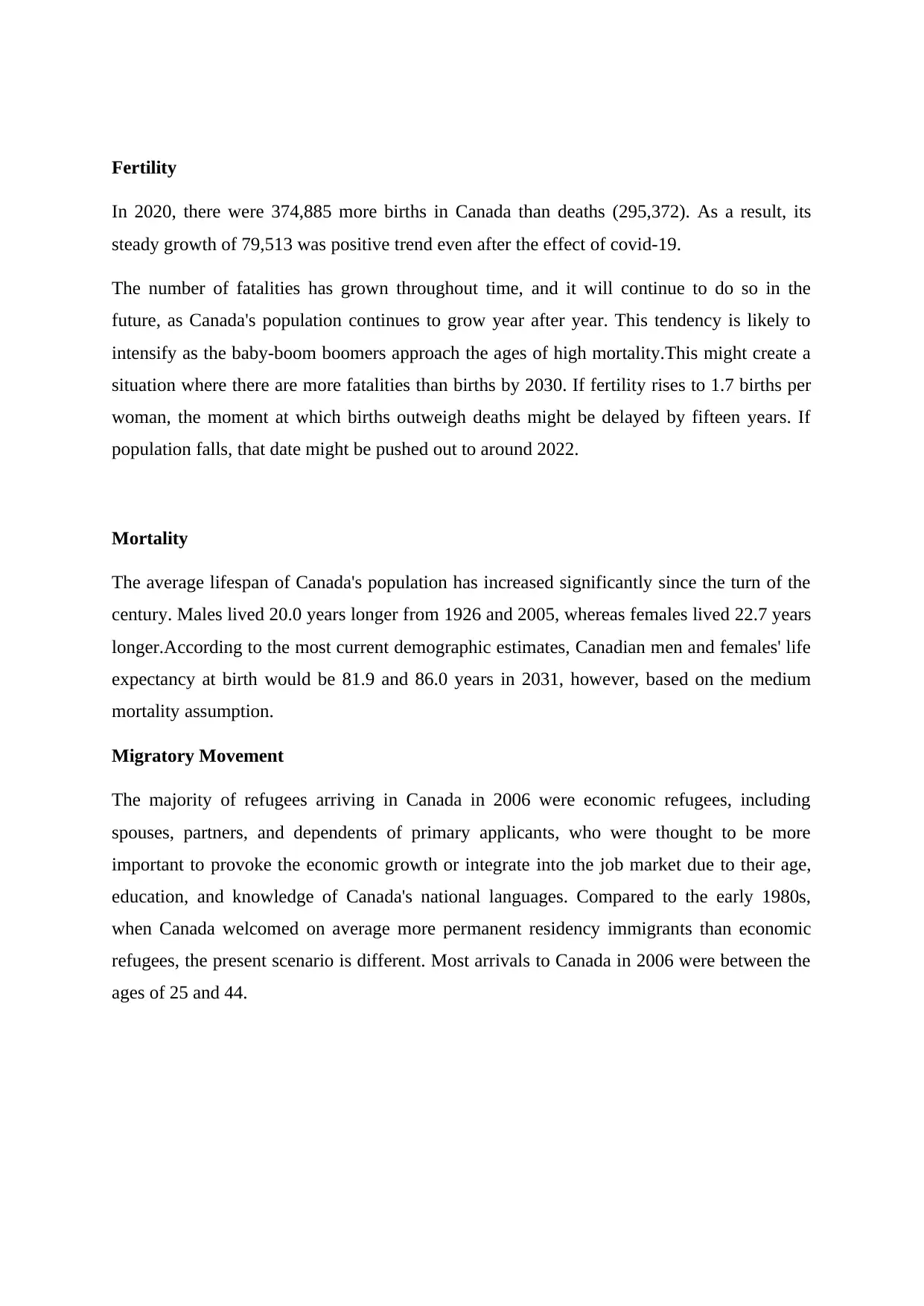
Fertility
In 2020, there were 374,885 more births in Canada than deaths (295,372). As a result, its
steady growth of 79,513 was positive trend even after the effect of covid-19.
The number of fatalities has grown throughout time, and it will continue to do so in the
future, as Canada's population continues to grow year after year. This tendency is likely to
intensify as the baby-boom boomers approach the ages of high mortality.This might create a
situation where there are more fatalities than births by 2030. If fertility rises to 1.7 births per
woman, the moment at which births outweigh deaths might be delayed by fifteen years. If
population falls, that date might be pushed out to around 2022.
Mortality
The average lifespan of Canada's population has increased significantly since the turn of the
century. Males lived 20.0 years longer from 1926 and 2005, whereas females lived 22.7 years
longer.According to the most current demographic estimates, Canadian men and females' life
expectancy at birth would be 81.9 and 86.0 years in 2031, however, based on the medium
mortality assumption.
Migratory Movement
The majority of refugees arriving in Canada in 2006 were economic refugees, including
spouses, partners, and dependents of primary applicants, who were thought to be more
important to provoke the economic growth or integrate into the job market due to their age,
education, and knowledge of Canada's national languages. Compared to the early 1980s,
when Canada welcomed on average more permanent residency immigrants than economic
refugees, the present scenario is different. Most arrivals to Canada in 2006 were between the
ages of 25 and 44.
In 2020, there were 374,885 more births in Canada than deaths (295,372). As a result, its
steady growth of 79,513 was positive trend even after the effect of covid-19.
The number of fatalities has grown throughout time, and it will continue to do so in the
future, as Canada's population continues to grow year after year. This tendency is likely to
intensify as the baby-boom boomers approach the ages of high mortality.This might create a
situation where there are more fatalities than births by 2030. If fertility rises to 1.7 births per
woman, the moment at which births outweigh deaths might be delayed by fifteen years. If
population falls, that date might be pushed out to around 2022.
Mortality
The average lifespan of Canada's population has increased significantly since the turn of the
century. Males lived 20.0 years longer from 1926 and 2005, whereas females lived 22.7 years
longer.According to the most current demographic estimates, Canadian men and females' life
expectancy at birth would be 81.9 and 86.0 years in 2031, however, based on the medium
mortality assumption.
Migratory Movement
The majority of refugees arriving in Canada in 2006 were economic refugees, including
spouses, partners, and dependents of primary applicants, who were thought to be more
important to provoke the economic growth or integrate into the job market due to their age,
education, and knowledge of Canada's national languages. Compared to the early 1980s,
when Canada welcomed on average more permanent residency immigrants than economic
refugees, the present scenario is different. Most arrivals to Canada in 2006 were between the
ages of 25 and 44.

Looking at the trends in british columbia’s size and population,it is evident that the
population distribution in british columbia(bc) has increased on a large scale in the last
century.The population in british columbia is estimated to be 4.8 million people as of 2017.It
is also found that the majority of british columbia lives in Metro Vancouver Region which is
estimated to be around 2.6 million people ie;around 50% of british columbia’s population
lives there.Capital Region gets the second place in terms of population with 390,000 people
living in that region.The Fraser valley and the Central Okanagan regions has got their fair-
share of bc population living there.
population distribution in british columbia(bc) has increased on a large scale in the last
century.The population in british columbia is estimated to be 4.8 million people as of 2017.It
is also found that the majority of british columbia lives in Metro Vancouver Region which is
estimated to be around 2.6 million people ie;around 50% of british columbia’s population
lives there.Capital Region gets the second place in terms of population with 390,000 people
living in that region.The Fraser valley and the Central Okanagan regions has got their fair-
share of bc population living there.
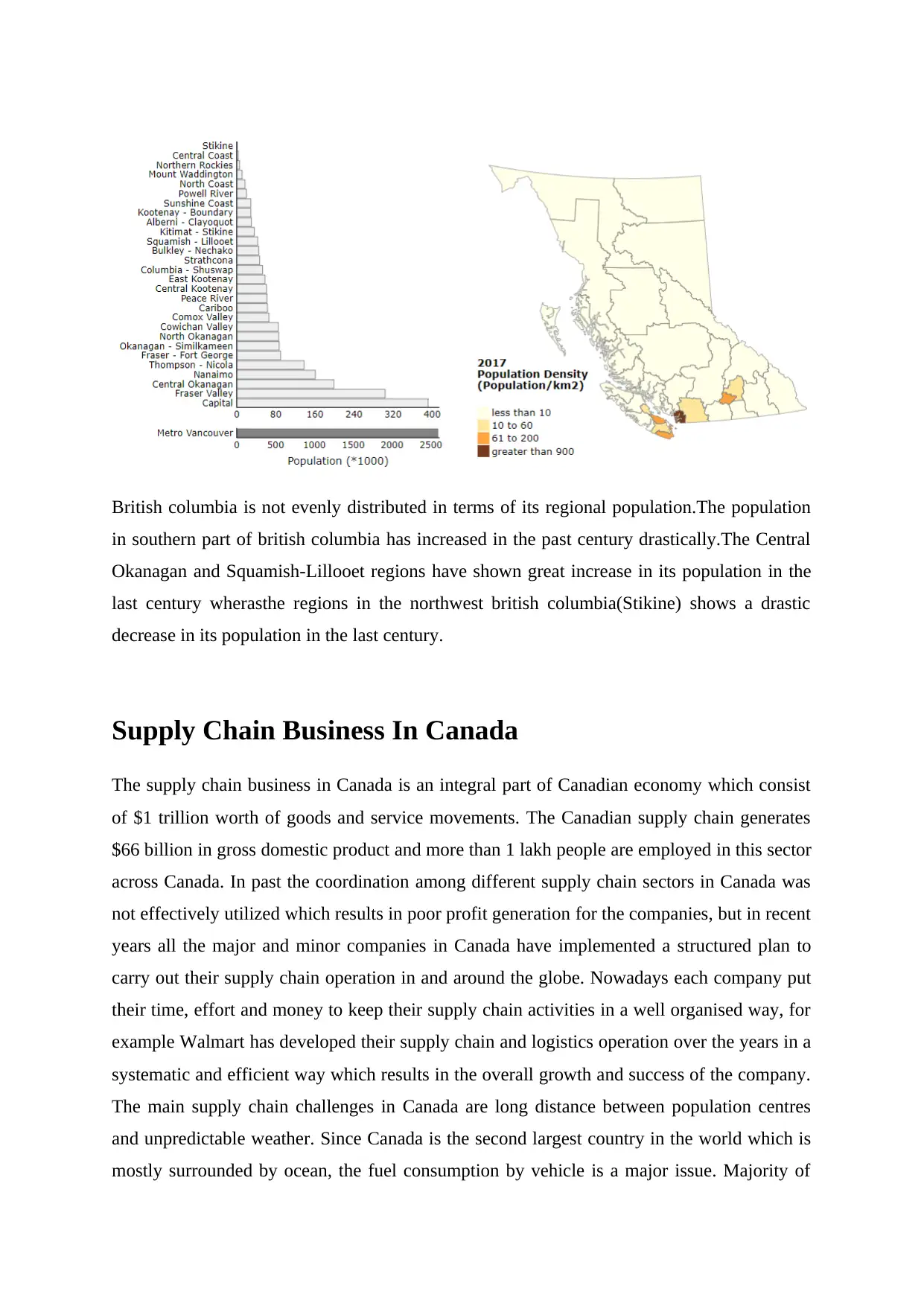
British columbia is not evenly distributed in terms of its regional population.The population
in southern part of british columbia has increased in the past century drastically.The Central
Okanagan and Squamish-Lillooet regions have shown great increase in its population in the
last century wherasthe regions in the northwest british columbia(Stikine) shows a drastic
decrease in its population in the last century.
Supply Chain Business In Canada
The supply chain business in Canada is an integral part of Canadian economy which consist
of $1 trillion worth of goods and service movements. The Canadian supply chain generates
$66 billion in gross domestic product and more than 1 lakh people are employed in this sector
across Canada. In past the coordination among different supply chain sectors in Canada was
not effectively utilized which results in poor profit generation for the companies, but in recent
years all the major and minor companies in Canada have implemented a structured plan to
carry out their supply chain operation in and around the globe. Nowadays each company put
their time, effort and money to keep their supply chain activities in a well organised way, for
example Walmart has developed their supply chain and logistics operation over the years in a
systematic and efficient way which results in the overall growth and success of the company.
The main supply chain challenges in Canada are long distance between population centres
and unpredictable weather. Since Canada is the second largest country in the world which is
mostly surrounded by ocean, the fuel consumption by vehicle is a major issue. Majority of
in southern part of british columbia has increased in the past century drastically.The Central
Okanagan and Squamish-Lillooet regions have shown great increase in its population in the
last century wherasthe regions in the northwest british columbia(Stikine) shows a drastic
decrease in its population in the last century.
Supply Chain Business In Canada
The supply chain business in Canada is an integral part of Canadian economy which consist
of $1 trillion worth of goods and service movements. The Canadian supply chain generates
$66 billion in gross domestic product and more than 1 lakh people are employed in this sector
across Canada. In past the coordination among different supply chain sectors in Canada was
not effectively utilized which results in poor profit generation for the companies, but in recent
years all the major and minor companies in Canada have implemented a structured plan to
carry out their supply chain operation in and around the globe. Nowadays each company put
their time, effort and money to keep their supply chain activities in a well organised way, for
example Walmart has developed their supply chain and logistics operation over the years in a
systematic and efficient way which results in the overall growth and success of the company.
The main supply chain challenges in Canada are long distance between population centres
and unpredictable weather. Since Canada is the second largest country in the world which is
mostly surrounded by ocean, the fuel consumption by vehicle is a major issue. Majority of
Secure Best Marks with AI Grader
Need help grading? Try our AI Grader for instant feedback on your assignments.

the population in Canada lives near US border, so US has significant impact on logistics
operation of Canada. Most of the people depend on US for purchasing goods as the price for
the products are very cheap compared to Canada because of less tax in US and more variety
is also available. In Canada there are 5 principal mode of transportation, that are rail, water,
motor carrier, air and pipeline. Major goods movements are carried through ports and the
main importers are US and China. The supply chain business in Canada can be enhanced by
collecting real time date and using upgraded technology.
Advantages of Canadian Supply Chain
Canada's strong road, rail, and water infrastructure, as well as the government's ongoing
investment in upgrades, have made it a place from which businesses can service global
markets. Making logistics a fundamental element of a company's business strategy has
become extremely important in today's global economy. A well-functioning supply chain
may significantly improve a company's competitiveness and profitability. Canada is more
equipped than any other country to meet these new problems.
In terms of logistics, Canada has clearly established itself as a global leader. The nation's
capacity to offer full and efficient international logistics capabilities is due to its excellent sea
ports, large railway networks, and high-quality highway and road infrastructure. And, thanks
to its strong commercial ties with the United States, Canada has positioned itself to help
Europe, North America, and Asia with international logistics. Canada has situated itself to
help Europe, North America, and Asia with international logistics.
Advantages of water transport.
Canada's major water ports are a huge worldwide advantage. Ocean ports on the pacific and
Atlantic coastlines, respectively, provide access to Asian and European markets. In addition,
the St. Lawrence Seaway provides increased port service to a number of great lakes sites in
Canada and the United States. The great lakes provide exceptional multimodal logistics
capabilities to Canada’s main provinces and the United States.
A basic geography lesson reveals that Canada possesses specific logistical skills that can be
utilized. Canada leads the world in port availability, infrastructure, and accessibility for
importing and exporting. Location, natural advantages, and logistics assistance have all
operation of Canada. Most of the people depend on US for purchasing goods as the price for
the products are very cheap compared to Canada because of less tax in US and more variety
is also available. In Canada there are 5 principal mode of transportation, that are rail, water,
motor carrier, air and pipeline. Major goods movements are carried through ports and the
main importers are US and China. The supply chain business in Canada can be enhanced by
collecting real time date and using upgraded technology.
Advantages of Canadian Supply Chain
Canada's strong road, rail, and water infrastructure, as well as the government's ongoing
investment in upgrades, have made it a place from which businesses can service global
markets. Making logistics a fundamental element of a company's business strategy has
become extremely important in today's global economy. A well-functioning supply chain
may significantly improve a company's competitiveness and profitability. Canada is more
equipped than any other country to meet these new problems.
In terms of logistics, Canada has clearly established itself as a global leader. The nation's
capacity to offer full and efficient international logistics capabilities is due to its excellent sea
ports, large railway networks, and high-quality highway and road infrastructure. And, thanks
to its strong commercial ties with the United States, Canada has positioned itself to help
Europe, North America, and Asia with international logistics. Canada has situated itself to
help Europe, North America, and Asia with international logistics.
Advantages of water transport.
Canada's major water ports are a huge worldwide advantage. Ocean ports on the pacific and
Atlantic coastlines, respectively, provide access to Asian and European markets. In addition,
the St. Lawrence Seaway provides increased port service to a number of great lakes sites in
Canada and the United States. The great lakes provide exceptional multimodal logistics
capabilities to Canada’s main provinces and the United States.
A basic geography lesson reveals that Canada possesses specific logistical skills that can be
utilized. Canada leads the world in port availability, infrastructure, and accessibility for
importing and exporting. Location, natural advantages, and logistics assistance have all
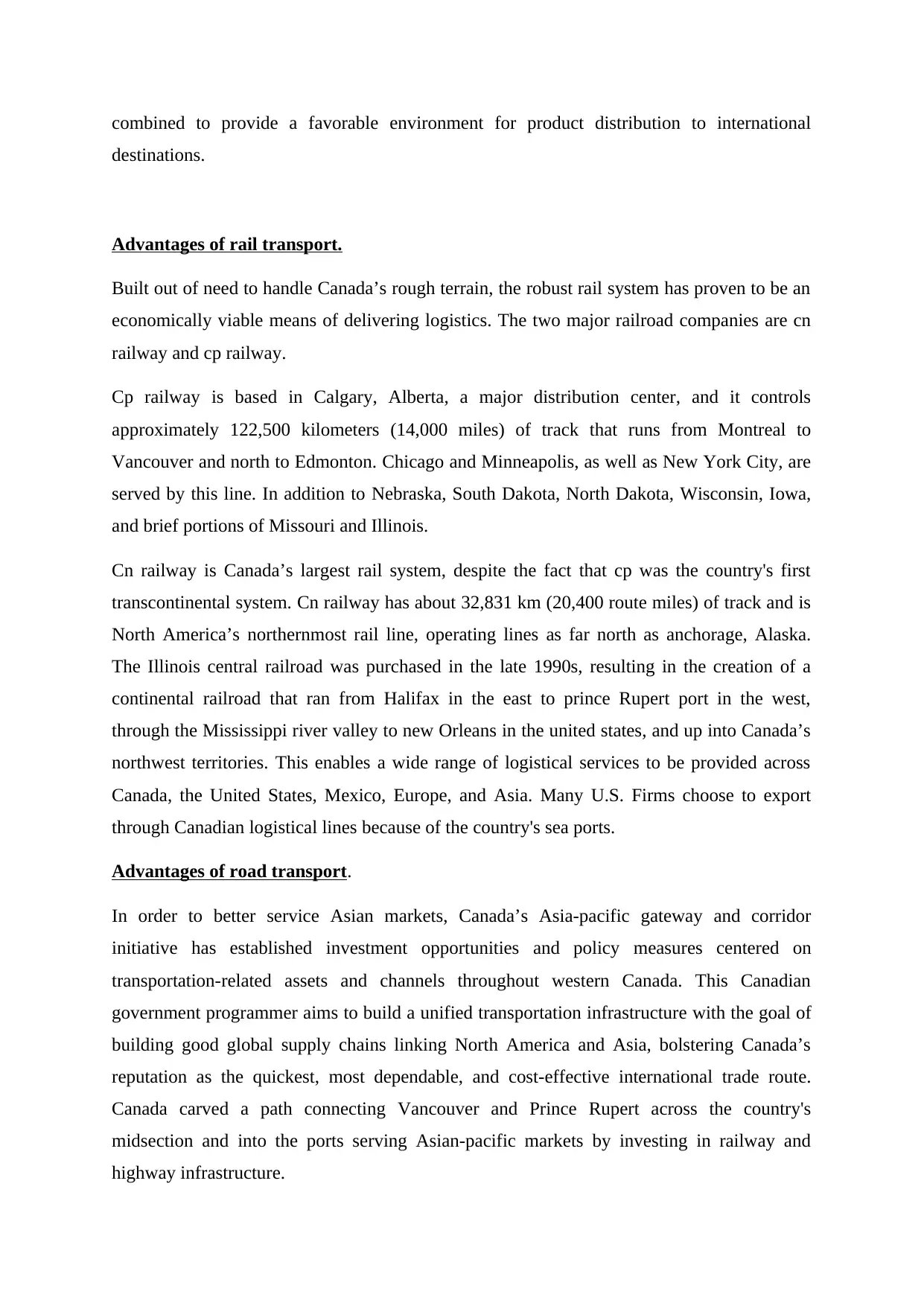
combined to provide a favorable environment for product distribution to international
destinations.
Advantages of rail transport.
Built out of need to handle Canada’s rough terrain, the robust rail system has proven to be an
economically viable means of delivering logistics. The two major railroad companies are cn
railway and cp railway.
Cp railway is based in Calgary, Alberta, a major distribution center, and it controls
approximately 122,500 kilometers (14,000 miles) of track that runs from Montreal to
Vancouver and north to Edmonton. Chicago and Minneapolis, as well as New York City, are
served by this line. In addition to Nebraska, South Dakota, North Dakota, Wisconsin, Iowa,
and brief portions of Missouri and Illinois.
Cn railway is Canada’s largest rail system, despite the fact that cp was the country's first
transcontinental system. Cn railway has about 32,831 km (20,400 route miles) of track and is
North America’s northernmost rail line, operating lines as far north as anchorage, Alaska.
The Illinois central railroad was purchased in the late 1990s, resulting in the creation of a
continental railroad that ran from Halifax in the east to prince Rupert port in the west,
through the Mississippi river valley to new Orleans in the united states, and up into Canada’s
northwest territories. This enables a wide range of logistical services to be provided across
Canada, the United States, Mexico, Europe, and Asia. Many U.S. Firms choose to export
through Canadian logistical lines because of the country's sea ports.
Advantages of road transport.
In order to better service Asian markets, Canada’s Asia-pacific gateway and corridor
initiative has established investment opportunities and policy measures centered on
transportation-related assets and channels throughout western Canada. This Canadian
government programmer aims to build a unified transportation infrastructure with the goal of
building good global supply chains linking North America and Asia, bolstering Canada’s
reputation as the quickest, most dependable, and cost-effective international trade route.
Canada carved a path connecting Vancouver and Prince Rupert across the country's
midsection and into the ports serving Asian-pacific markets by investing in railway and
highway infrastructure.
destinations.
Advantages of rail transport.
Built out of need to handle Canada’s rough terrain, the robust rail system has proven to be an
economically viable means of delivering logistics. The two major railroad companies are cn
railway and cp railway.
Cp railway is based in Calgary, Alberta, a major distribution center, and it controls
approximately 122,500 kilometers (14,000 miles) of track that runs from Montreal to
Vancouver and north to Edmonton. Chicago and Minneapolis, as well as New York City, are
served by this line. In addition to Nebraska, South Dakota, North Dakota, Wisconsin, Iowa,
and brief portions of Missouri and Illinois.
Cn railway is Canada’s largest rail system, despite the fact that cp was the country's first
transcontinental system. Cn railway has about 32,831 km (20,400 route miles) of track and is
North America’s northernmost rail line, operating lines as far north as anchorage, Alaska.
The Illinois central railroad was purchased in the late 1990s, resulting in the creation of a
continental railroad that ran from Halifax in the east to prince Rupert port in the west,
through the Mississippi river valley to new Orleans in the united states, and up into Canada’s
northwest territories. This enables a wide range of logistical services to be provided across
Canada, the United States, Mexico, Europe, and Asia. Many U.S. Firms choose to export
through Canadian logistical lines because of the country's sea ports.
Advantages of road transport.
In order to better service Asian markets, Canada’s Asia-pacific gateway and corridor
initiative has established investment opportunities and policy measures centered on
transportation-related assets and channels throughout western Canada. This Canadian
government programmer aims to build a unified transportation infrastructure with the goal of
building good global supply chains linking North America and Asia, bolstering Canada’s
reputation as the quickest, most dependable, and cost-effective international trade route.
Canada carved a path connecting Vancouver and Prince Rupert across the country's
midsection and into the ports serving Asian-pacific markets by investing in railway and
highway infrastructure.
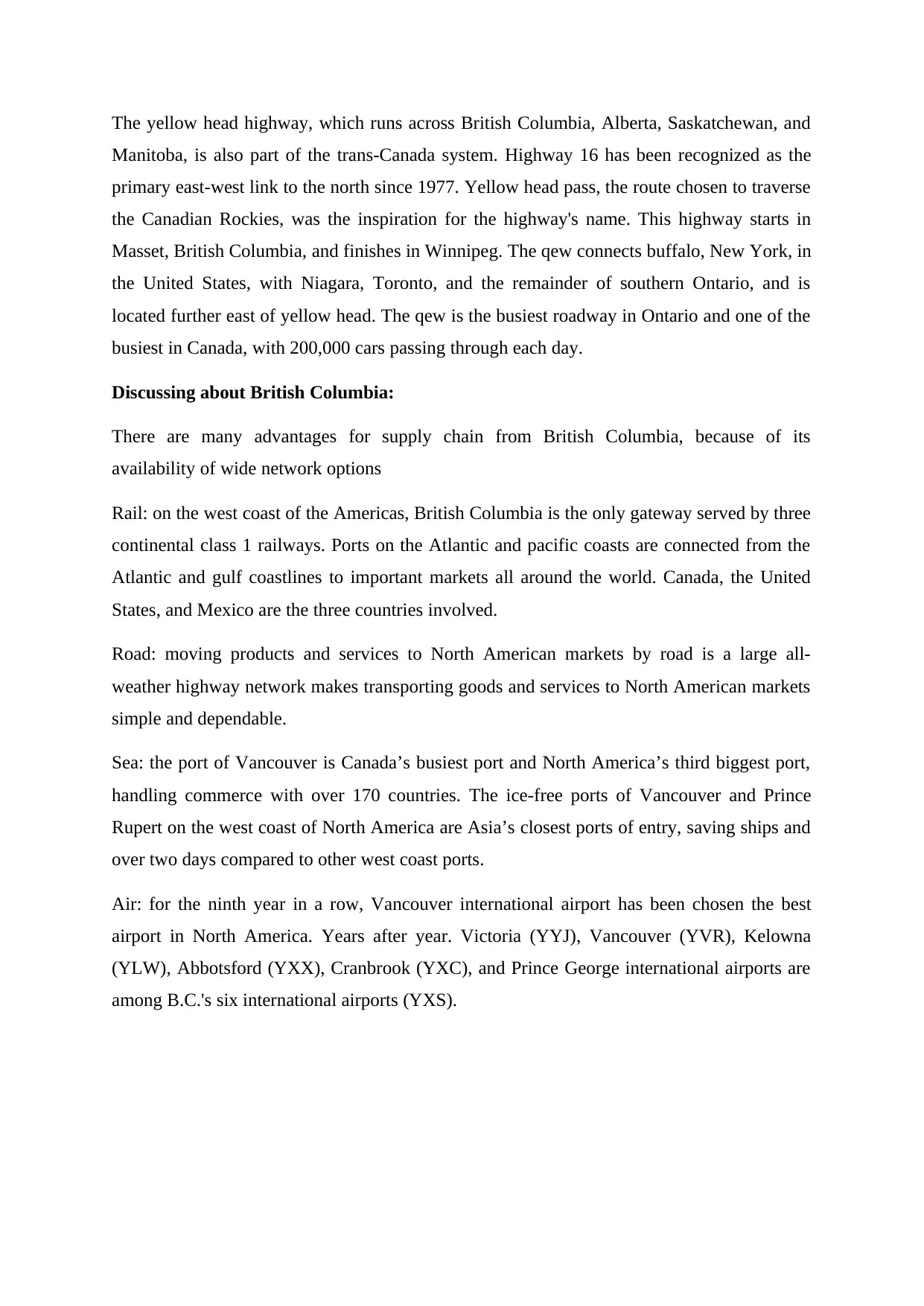
The yellow head highway, which runs across British Columbia, Alberta, Saskatchewan, and
Manitoba, is also part of the trans-Canada system. Highway 16 has been recognized as the
primary east-west link to the north since 1977. Yellow head pass, the route chosen to traverse
the Canadian Rockies, was the inspiration for the highway's name. This highway starts in
Masset, British Columbia, and finishes in Winnipeg. The qew connects buffalo, New York, in
the United States, with Niagara, Toronto, and the remainder of southern Ontario, and is
located further east of yellow head. The qew is the busiest roadway in Ontario and one of the
busiest in Canada, with 200,000 cars passing through each day.
Discussing about British Columbia:
There are many advantages for supply chain from British Columbia, because of its
availability of wide network options
Rail: on the west coast of the Americas, British Columbia is the only gateway served by three
continental class 1 railways. Ports on the Atlantic and pacific coasts are connected from the
Atlantic and gulf coastlines to important markets all around the world. Canada, the United
States, and Mexico are the three countries involved.
Road: moving products and services to North American markets by road is a large all-
weather highway network makes transporting goods and services to North American markets
simple and dependable.
Sea: the port of Vancouver is Canada’s busiest port and North America’s third biggest port,
handling commerce with over 170 countries. The ice-free ports of Vancouver and Prince
Rupert on the west coast of North America are Asia’s closest ports of entry, saving ships and
over two days compared to other west coast ports.
Air: for the ninth year in a row, Vancouver international airport has been chosen the best
airport in North America. Years after year. Victoria (YYJ), Vancouver (YVR), Kelowna
(YLW), Abbotsford (YXX), Cranbrook (YXC), and Prince George international airports are
among B.C.'s six international airports (YXS).
Manitoba, is also part of the trans-Canada system. Highway 16 has been recognized as the
primary east-west link to the north since 1977. Yellow head pass, the route chosen to traverse
the Canadian Rockies, was the inspiration for the highway's name. This highway starts in
Masset, British Columbia, and finishes in Winnipeg. The qew connects buffalo, New York, in
the United States, with Niagara, Toronto, and the remainder of southern Ontario, and is
located further east of yellow head. The qew is the busiest roadway in Ontario and one of the
busiest in Canada, with 200,000 cars passing through each day.
Discussing about British Columbia:
There are many advantages for supply chain from British Columbia, because of its
availability of wide network options
Rail: on the west coast of the Americas, British Columbia is the only gateway served by three
continental class 1 railways. Ports on the Atlantic and pacific coasts are connected from the
Atlantic and gulf coastlines to important markets all around the world. Canada, the United
States, and Mexico are the three countries involved.
Road: moving products and services to North American markets by road is a large all-
weather highway network makes transporting goods and services to North American markets
simple and dependable.
Sea: the port of Vancouver is Canada’s busiest port and North America’s third biggest port,
handling commerce with over 170 countries. The ice-free ports of Vancouver and Prince
Rupert on the west coast of North America are Asia’s closest ports of entry, saving ships and
over two days compared to other west coast ports.
Air: for the ninth year in a row, Vancouver international airport has been chosen the best
airport in North America. Years after year. Victoria (YYJ), Vancouver (YVR), Kelowna
(YLW), Abbotsford (YXX), Cranbrook (YXC), and Prince George international airports are
among B.C.'s six international airports (YXS).
Paraphrase This Document
Need a fresh take? Get an instant paraphrase of this document with our AI Paraphraser

Conclusion
After conducting detailed research for this study, it is discovered that Canada's population
and location has an immense impact on its citizens. It is discovered that the population
density is highest in the lower half of Canada, which is also where the cities, transit lines, and
the bulk of people reside. Furthermore, Canada's large ports assist them in connecting to the
rest of the world and simplifying the export-import procedure. Throughout the study, we
discovered that Canada has a diverse population, which makes it a distinct country.
Furthermore, geography has had a significant impact on the country's development. National
and provincial politics, transportation and trade, as well as national security and foreign
policy are all affected immensely by this factor. As agriculture is not viable in 90% of
Canada owing to the cold, Canada has built up its supply chain to the point that it is one of
the top countries in terms of foreign commerce.
After conducting detailed research for this study, it is discovered that Canada's population
and location has an immense impact on its citizens. It is discovered that the population
density is highest in the lower half of Canada, which is also where the cities, transit lines, and
the bulk of people reside. Furthermore, Canada's large ports assist them in connecting to the
rest of the world and simplifying the export-import procedure. Throughout the study, we
discovered that Canada has a diverse population, which makes it a distinct country.
Furthermore, geography has had a significant impact on the country's development. National
and provincial politics, transportation and trade, as well as national security and foreign
policy are all affected immensely by this factor. As agriculture is not viable in 90% of
Canada owing to the cold, Canada has built up its supply chain to the point that it is one of
the top countries in terms of foreign commerce.

THANK YOU
1 out of 15
Related Documents
Your All-in-One AI-Powered Toolkit for Academic Success.
+13062052269
info@desklib.com
Available 24*7 on WhatsApp / Email
![[object Object]](/_next/static/media/star-bottom.7253800d.svg)
Unlock your academic potential
© 2024 | Zucol Services PVT LTD | All rights reserved.
